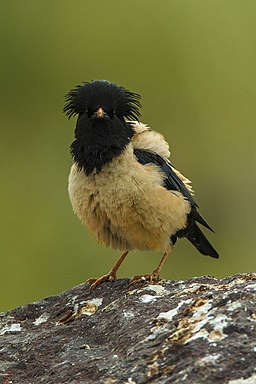UPDATE: Rose-coloured Starlings have apparently turned up at The Genome Campus, Hinxton, near Cambridge. It’s private land, so don’t go looking on the site as you’re liable to be arrested. The birds are flocking to and from the village itself and there is a neighbouring paddock they seem to be favouring.
—
According to BirdGuides.com: “2018 is poised to produce a huge invasion of Rosy Starlings to the UK”
Many have been seen in record-breaking numbers in recent days across continental Europe with flocks appearing as close as France, says the site. 500 were recorded in Marseille and some in Spain. Fewer than 20 have been reported in the UK so far but that’s more than normal numbers in a seven-day period. The site suggests they could be “harbingers of a much larger arrival”. Sightings have been made in Dorset, Cornwall, Kent, Anglesey, Hampshire, Northamptonshire, Norfolk, East Yorkshire, and the Isle of Skye.
Although it is nominally a starling, the rosy starling (Pastor roseus) or rose-coloured pastor is now classed in its own monotype genus as “Pastor” rather than bunched with the starling family, Sturnidae. The split is based on genetics and it is not yet known whether there are other members of the genus yet to be revealed.
The genus name Pastor and its old English name come from the Latin word pastor, meaning “shepherd” (as in pastoral, but also as in a priest). Roseus is Latin for “rose-coloured”, as you probably guessed. You can see from Veronesi’s below why they’re called pastors, it’s nothing to do with looking like a priest, it’s that they look like they’re wearing a sheep’s fleece as a shepherd would.
Not my photo, but if I see one, I will endeavour to snap it:
